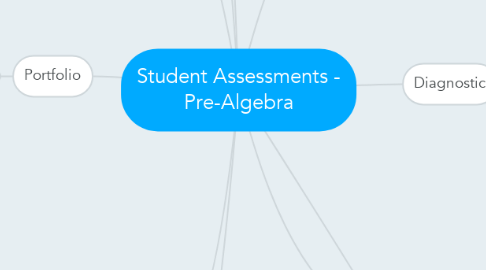
1. References: High-Stakes Test Definition. (2013). Retrieved May 31, 2016, from http://edglossary.org/high-stakes-testing/ S. (2010). Rick Wormeli: Formative and Summative Assessment. Retrieved May 31, 2016, from https://www.youtube.com/watch?v=rJxFXjfB_B4 E. (2010). Comprehensive Assessment: An Overview. Retrieved May 31, 2016, from https://www.youtube.com/watch?v=b9OBhKzh1BM M. (2011). The Formative Classroom. Retrieved May 31, 2016, from https://www.youtube.com/watch?v=rL54bfmZPzY "What Is Authentic Assessment? (Authentic Assessment Toolbox)." What Is Authentic Assessment? (Authentic Assessment Toolbox). Web. 31 May 2016.
2. Performance-Based
2.1. Definition: An assessment where students demonstrate the skills and knowledge developed in class.
2.1.1. Purposes: Measures how well students can apply or use what they know in real-world situations.
2.1.1.1. Advantages: ▪ Emphasizes practical application of skills ▪ Provides teachers with more information ▪ Allows for self-assessments
2.1.1.1.1. Assessment “of” learning AND Assessment “for” learning: This type of assessment is mainly an assessment “of” learning because it is monitoring learning however due to the application of knowledge and opportunity for self-assessment with feedback from self and peers, it is also an assessment “for” learning.
2.1.1.2. Disadvantages: ▪ Difficult to distinguish right versus wrong answers (can be avoided with a clear rubric) ▪ Difficult to make consistent across teachers
3. High-Stakes
3.1. Definition: A test with a direct benefits or consequences for the test taker.
3.1.1. Purposes: ▪ Used to make important decisions about students ▪ state or district testing
3.1.1.1. Advantages: ▪ Data is typically publicly available ▪ Can help teachers create a plan based on results
3.1.1.1.1. Assessment “of” learning: A high stakes test is purely used to monitor student learning and assess if they ready to move on to the next level.
3.1.1.2. Disadvantages: ▪ Cause anxiety ▪ May cause a student who is just a bad test taker to repeat a year ▪ Does not always accurately reflect students’ skills ▪ Has caused many schools to cut back on other subject areas due to the importance of high stakes tests
4. Portfolio
4.1. Definition: A systematic collection of work
4.1.1. Purposes: ▪ Displays a students accomplishments and samples of work throughout a set amount of time ▪ observe growth over time
4.1.1.1. Advantages: ▪ Promotes critical thinking ▪ based on samples of work ▪ Flexible grading options ▪ Meets more students’ learning styles
4.1.1.1.1. Assessment “of” Learning: Portfolio Assessment is monitoring student learning but from a different perspective than summative assessments.
4.1.1.2. Disadvantages: ▪ Can be bulky and difficult to manage ▪ Can be costly in time to grade
5. Authentic
5.1. Definition: An assessment where students answer real-world problems
5.1.1. Purposes: ▪ It's a way to assess students’ skills when applied to real-world problems rather than a traditional standardized questions. ▪ Relevant real-world tasks
5.1.1.1. Advantages: ▪ promotes creativity ▪ applies critical thinking and real-world application ▪ encourages teamwork
5.1.1.1.1. Assessment “of” learning: This is an assessment that judges if the skills taught can be applied in the real-world.
5.1.1.2. Disadvantages: ▪ difficulty with consistent grading and comparing across classes ▪ may take a lot of time
6. Self-Assessment
6.1. Definition: A self-assessment is a reflection on ones growth or understanding
6.1.1. Purposes: It provides motivation and critical thinking.
6.1.1.1. Advantages: ▪ encourages students to take responsibility for their work ▪ develops reflective and awareness skills
6.1.1.1.1. Assessment “of” learning and “for” learning: Monitors self learning which leads to affecting future learning
6.1.1.2. Disadvantages: ▪ requires teaching of to evaluate yourself ▪ can lead to inflated grades
7. Peer Assessment
7.1. Definition: Give and receive feedback from peers
7.1.1. Purposes: Can save time and improve students’ understanding of the skills learned in class
7.1.1.1. Advantages: ▪ encourages involvement, awareness, and responsibility ▪ team building ▪ can help with the freeloader issue with team projects
7.1.1.1.1. Assessment “of” learning and “for” learning: Similar to self-assessment, monitors self learning which leads to affecting future learning
7.1.1.2. Disadvantages: ▪ not always very reliable due to students’ worries about peers ▪ students may reward everyone with same/similar grade ▪ can hurt student confidence
8. Formative
8.1. Definition: An assessment to assess how students are progressing towards a specific objective.
8.1.1. Purpose: Checkpoint along the way (a check for understanding)
8.1.1.1. Advantages: ▪ Descriptive feedback ▪ Affect is much greater than summative ▪ MANY types of formative assessments
8.1.1.1.1. Assessment “For” Learning: Formatives give descriptive feedback that have an effect on the actual learning itself. They help the teacher have immediate feedback as to how the students are doing but it also helps the students know exactly what they are doing correctly or incorrectly.
8.1.1.2. Disadvantages: ▪ Costs time ▪ May require training ▪ Students may not take it seriously
9. Diagnostic
9.1. Definition: A pre-assessment designed to provide teachers with students’ prior knowledge, misconceptions, and a baseline.
9.1.1. Purposes: ▪ Provides teachers with students’ prior knowledge, misconceptions, and a baseline ▪ May also provide students with a glimpse of the upcoming material ▪ Drives the teaching
9.1.1.1. Advantages: ▪ Allows for more accurate data usage (because of the baseline) ▪ More information for differentiation
9.1.1.1.1. Assessment “for” learning: A diagnostic assessment is designed to increase student learning by creating a baseline, informing on misconceptions, and discovering prior knowledge.
9.1.1.2. Disadvantages: ▪ May be misleading or inaccurate and cause the teacher to make choices in appropriate for the students
10. Summative
10.1. Definition: An evaluation of student learning at the end of a unit of some sort.
10.1.1. Purposes: ▪ To evaluate student learning compared to a standard. ▪ end of unit
10.1.1.1. Advantages: ▪ May be turned into a formative assessment ▪ Provide motivation to students ▪ Great information for teachers
10.1.1.1.1. Assessment “of” Learning: This is an assessment of the learning that has already taken place. It is intended to monitor student learning but may be turned into a formative if needed.
10.1.1.2. Disadvantages: ▪ May cause teachers to “teach to the test” ▪ Some students get anxious or aren’t great test takers
